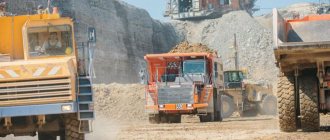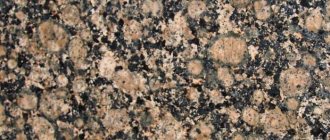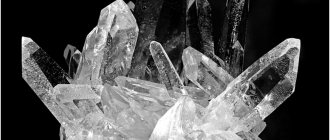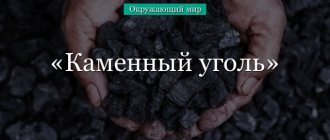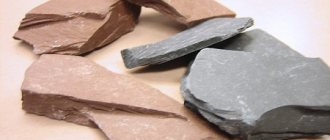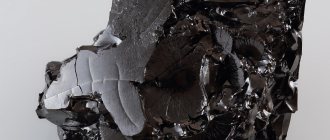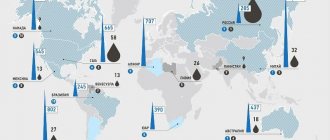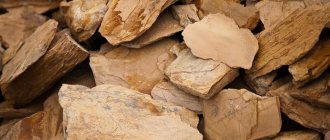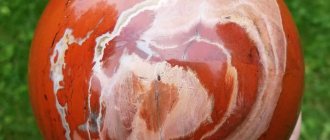About the company / Useful articles / What is slate stone
What is slate stone
Category: Useful articles
Slate is a rock with a nearly parallel arrangement of plate-like minerals. Its main difference from other volcanic formations is its ability to split into thin sheets. You can buy slate to solve a variety of problems.
Slate is not used in jewelry, but it is often used to create amulets, amulets, jewelry and other things.
Construction slate is in demand for the construction of basement floors and all kinds of architectural partitions. Tiles made from this mineral are resistant to physical and chemical damage, which allows them to be used for both internal and external work.
Slate roofs have been made for such world-famous buildings as Buckingham Palace, Edinburgh Castle and the Louvre
Oil shale
Oil shale (OS) - pyrobituminous shale - sedimentary rocks of carbonate-clayey (marly), clayey or siliceous composition, containing 10-50%, rarely up to 60%, syngenetic sedimentation of organic matter kerogen.
GS have a brown, brown-yellow, gray, olive-gray color, leafy or massive texture.
Shale formations are rocks consisting of clayey limestones and silica, which are saturated with organic matter (OM). These are the main oil source rocks in almost all oil and gas basins of the world. The term "Oil shale" is sometimes used to designate all high-ash solid caustobioliths containing organic substances of various origins and various transformation conditions (carbonaceous, bituminous and liptobiolite shales). Kerogen-syngenetic organic substance with sedimentation with a high yield of resins during dry distillation, with a limited yield of bitumen, extracted with organic solvents at low temperatures. It is rich in hydrogen and its content is closer to oil than to coal. Geologically, kerogen is proto-oil; its content in oil shale ranges from 10% to 60-80%. The starting material for the organic matter of oil shale was the biomass of predominantly lower algae (sapropelic components), to a lesser extent higher plants (humus components) and partly animal organisms. According to the ratio of sapropel and humus components, HSs are divided into: sapropelites (HSs of the Baltic shale basin, Volga basin and Boltysh deposit),
saprohumites (menilite schists of the Carpathians). A distinctive genetic feature of the organic matter of most hydrocarbons is its accumulation in bottom sediments under normal oxygen conditions. The organic matter of HS is characterized by a high hydrogen content (7-10%), a high yield of volatiles during thermal processing (up to 90%), and a high specific heat of combustion (Qbdaf = 29-37 MJ/kg). The main mineral components of the GS are calcite, quartz and clay minerals; feldspars, pyrite, and accessory minerals are of subordinate importance.
Types of classification of natural stones and minerals
Natural stones and minerals are classified according to their type of origin, composition, hardness, transparency, value and other properties. There are monomineral rocks, consisting of one mineral, and polymineral rocks, consisting of two or more minerals.
In order to distinguish valuable species from decorative ones, various classifications have been compiled. The most relevant of them is the classification of Bauer and Kluge, which includes precious and jewelry stones. The mineralogist Fersman made a significant contribution to its development, adding division into groups and classes.
Other classifications:
- on optical characteristics - compiled by Georg Gurich in 1902;
- at market value - proposed by Evgeny Kievlenko in 1973;
- according to physical and chemical characteristics - created by the All-Union Scientific Research Institute of the Jewelry Industry in the 80s of the 20th century.
What is oil shale?
Oil shale is a type of sedimentary rock that can be used to extract oil, the difficulty of extracting it has historically made it unconventional for the oil and gas industry.
Despite the similarity of names, shale is different from "shale oil". The latter refers to pockets of gas or liquid oil that occur in shale formations such as the Bakken Formation, which extends between North Dakota, Montana, Saskatchewan and Manitoba.
Shale oil - oil of 2 types (according to the classification accepted in the USA):
- Shale oil is a highly viscous shale resin that is significantly different in density and viscosity from traditional oil. Obtained from oil shale after thermal exposure;
- Tight oil - light oil contained in dense, low-porosity and low-permeability reservoirs
The search for shale oil requires new technologies because hydrocarbons are present without a visible seal, are not confined to uplift and without the classic gas-oil-water contact.
Light oil
Light oil (also known as shale oil, shale oil or low-permeability light oil) is light crude oil found in ultra-low permeability oil-bearing formations, often shales or tight sands, but with high oil saturation.
Commercial production from tight oil reservoirs requires the same hydraulic fracturing (fracturing) and often uses the same horizontal well technology as shale gas production.
Although shale oil is sometimes called "shale oil", recently oil shale and shale hydrocarbons have been distinguished
Oil shale is a rock saturated with kerogen, a precursor to oil.
The International Energy Agency (IEA) now recommends using the term “light tight oil” for oil produced from shale or other formations with very low permeability.
Previously, a 2013 World Energy Council report used the terms “tight oil” and “shale rocks.”
Oil and gas bearing shale formations are heterogeneous and vary greatly even over relatively short distances.
Low-permeability reservoirs after hydraulic fracturing can be divided into 4 groups:
- have low matrix porosity and permeability, resulting in cracks dominating both the storage vessel and fluid flow paths;
- have low matrix porosity and permeability, but the matrix provides capacity while the fractures provide fluid flow paths.
- have reservoir microporosity with high matrix porosity but low matrix permeability, which ensures the predominance of induced fractures in fluid paths;
- have macroporous reservoirs with high matrix porosity and permeability, which provides both capacity and flow paths, and fractures only increase permeability.
Due to the variability of well production, it is difficult to evaluate the results and make decisions regarding the profitability of wells. Producing oil from tight reservoirs requires at least 20% natural gas in the reservoir pore space to drive the oil to the wellbore. Hard-to-recover reserves in a reservoir containing only oil may not be economic to extract. Formations that form in marine environments contain less clay and are more brittle, and are therefore more suitable for hydraulic fracturing than formations formed in fresh water, which may contain more clay. Formations with more quartz and carbonate are more fragile.
According to various estimates, the reserves of oil shale and shale oil in the world are estimated at 650 trillion tons, which contain 550 - 630 billion tons of shale resin (artificial oil), which is even more than the proven reserves of natural oil.
Varieties
There is a huge variety of slates. Their appearance and qualities are determined by deposits, mineralogical composition, and formation conditions. They could have formed in the bowels of the planet with the participation of volcanic activity or on the seabed, where clay and other substances were compressed under the pressure of the mountains. The former are called orthoschists, the latter - paraschists.
Slate is a collective name for rocks of different composition. They include the following types:
- clayey;
- slate;
- crystalline;
- carbonaceous;
- chlorite;
- flammable;
- veld;
- talc, etc.
Many characteristics of rocks depend on the depth at which they were formed. At greater depths, the pressure is stronger and the temperature is higher. Under such conditions, the rock acquires a crystalline structure. It has well-defined layers that are easily separated into plates.
The layers may be weakly expressed and resemble crumpled folds. This occurs if the stones were formed with the help of sedimentary rocks at a relatively shallow depth, and the pressure was directed towards the layers.
Main characteristics of slate
Natural slates are composed of different minerals. The rock was formed under high pressure and exposure to different temperatures.
The advantage of the breed is:
- Resistant to moisture.
- Fire resistance.
- Immunity to natural factors.
Their formation occurred several million years ago during the period of movement of tectonic plates, volcanic eruptions and geysers. The slates are based on dark-colored stones with particles of silicon and feldspar. Some rocks contain mica.
What does it look like
Natural slate is a rock with a schistose structure. According to the established rule, the name is given according to the rock-forming minerals according to the 1-2-3 scheme. The mineral that is the least abundant in a mineral and becomes the first in the name:
- chlorite – chlorite, epidote, quartz;
- garnet - garnet, quartz, feldspar.
In general, the color of the stone is varied, with pronounced shades, mainly depending on the host minerals. The most common are gray and black. The black color has a graphite tint with a matte sheen, while the gray one has an oily sheen predominates.
Black slate
Slate multicolor
Gray slate
Slate black graphite
Natural burgundy slate
Deposits in Russia and the world
The largest shale deposits in the world are located:
- Mongolia;
- countries of Central Asia;
- China;
- Canada;
- USA;
- Brazil;
- Kazakhstan;
- central Europe;
- Republic of Belarus;
- Estonia;
- Ukraine.
On the territory of the CIS countries, the largest deposits are the Volzhskoye, Pribaltiyskoye, Kenderlykskoye (Kazakhstan), and the Arctic.
The main deposits in Russia where mineral extraction takes place:
- Siberia;
- Ural (Ekaterinburg);
- Leningrad region;
- Kirov region;
- Kostroma region;
- Komi Republic;
- Chuvashia;
- North Caucasus.
Where and how is the rock mined?
Shale deposits are found in different countries. The most common types of shales are clayey and crystalline. Deposits are being developed in a number of Asian countries, the USA, Brazil, Central Europe, Belarus, and Estonia. In Russia, slate stone is mined:
- in the Urals;
- in Siberia;
- Leningrad, Kirov, Kostroma regions;
- near Yekaterinburg;
- in Mordovia, Chuvashia, and the North Caucasus.
Chlorite shales are the least common variety. However, one of the largest deposits of this rock was discovered near the Ural Mountains. There are also deposits of these minerals in other countries:
- in Austria;
- on the Australian mainland;
- on the British islands;
- in Turkey;
- on the island of Madagascar;
- in South Africa;
- on the American continent;
- in China.
Large-scale oil shale development is underway in Canada and the United States. Rock is mined using two methods:
- Open or career. At the location of the mineral deposit, the upper layers of the earth are removed. After the stone monolith is opened, trenching begins. Lumps of material are broken off using special tools and loaded onto vehicles. As rock is removed, quarries of varying depths are formed. This is the most environmentally friendly mining method.
- Underground. Most often used to extract oil shale and shale gas. The method involves drilling deep wells using expensive and complex equipment, and is therefore very expensive. Underground mining carries a high risk of environmental pollution. This method can only be used in areas remote from populated areas, forests and water resources.
Types of slate
Shales vary in composition and are divided into the following types:
- crystalline schists - the composition is dominated by mica and quartz, often of a gray tint, this also includes biotite schist with a predominance of black mica-biotite, they have medium hardness, low thermal conductivity and high heat resistance;
- siliceous rock - consists of dense plates with chalcedony and quartz grains. Depending on the impurities it has different colors. Solid in density, with a low level of moisture absorption, not sensitive to temperature changes;
- oil shale - the name speaks for itself, is highly flammable, has average density, looks like hardened clay, and when burned, produces a pungent odor and soot;
- clay shale is a dark-colored mineral, hard, resistant to high temperatures, insoluble in water, with inclusions of clay particles, chlorite and hydromica, emits a clayey odor when wet;
- chlorite slate - due to the chlorite content, the stone has a green color with a shiny surface, brittle, non-flammable, with a high ability to absorb sounds;
- slate slate is a soft mineral of a gray hue, easily layered into columns;
- artificial slate.
Types of slate and their properties
The name “slate” combines many natural stones of different composition and properties, which can be divided into thinner layers. They are divided into groups depending on their composition and general characteristics. Each variety also has several subspecies.
The table provides a brief description of the different shale rocks:
| Group | General characteristics | Characteristic properties | Varieties and their descriptions |
| Clayey | Formed from mineral deposits with various impurities. They can be based on: sericite, quartz, chlorite. Color – black, brown, greyish, green, red. |
|
|
| Crystalline | Stones formed from mica and quartz. Most often they have gray shades. |
|
|
| Siliceous | They are formed from quartz or chalcedony with clay admixtures. The color depends on the amount and characteristics of impurities. There are red, green, purple, black and gray shales. |
|
|
| Chlorite | The basis of the rock is chlorite. The stones are green in color, shimmer, and have a shine. |
|
|
| Flammable | In appearance they look like frozen clay. The color of the rock is yellow, gray and dark gray. |
| They can be divided according to the principle of territorial location and the impurities included in them. |
White
White slate or “alpine” is a rock consisting of layers of plate-like minerals. The composition is dominated by gypsum, so the decorative stone is endowed with such qualities as:
- thermal insulation;
- durability;
- ease;
- strength.
It is resistant to sudden temperature changes, although it is fragile due to its layering. You need to work with it very carefully.
From plaster
Artificial slate made from gypsum has one significant drawback: it can only be used in dry rooms. Gypsum cannot withstand high humidity, as it quickly absorbs moisture and swells.
Advantages:
- ease;
- strength;
- heat capacity.
Important: You can make gypsum tiles yourself by choosing suitable molds for production. Read about pouring decorative stone with your own hands here.
weathered
Weathered is an artificially created material , its texture is very similar to a natural mineral due to its relief chipped surface.
Advantages:
- low price;
- light weight - installation is faster and easier;
- resistance to physical and chemical influences;
- ease of processing - does not crumble, does not delaminate;
- variety of colors and textures.
Classical
Classic material - not too embossed, moderately porous, not bulky. It can be used in any interior. Most often it is used for cladding a large room.
If you need to cover an entire wall, then classic slate with its fine texture is ideal for such a design solution.
Advice: A surface lined with such material will harmonize well with a flat, smoothly painted wall, which will emphasize the beauty and simplicity of the stone.
Large
Decorative slate with a pronounced texture in the interior looks impressive and unusual. Large relief and large differences create a spectacular design. This stone is made from gypsum (for interior work) or cement.
Thin layer
Sheet shale is a rock that has been fractured into thin sheets. They are stacked one on top of the other, with the end of each element visible on the decorative surface. In contrast to the sizes and proportions of other types of elements, the thin-layer material is small in size, with a more pronounced relief and sharp corners.
Additional Information
Mineral deposits are mined almost all over the world. Slate cookware is in demand as it is impact-resistant and hypoallergenic. Pathogenic microorganisms do not multiply on it. The properties of the rock are beyond the understanding of the human mind. Many sorcerers used the stone to perform special rituals. The mineral is capable of revealing the secrets of the past and future. Using it, you can see a prophetic dream that will reveal some secrets.
This rock helps protect against evil forces. If you keep it near you, it will strengthen your aura and protect you from negative influences. For anyone who has recently broken off a relationship, such a mineral will help quickly make up for the loss.
The healing properties of slate are also actively used to eliminate emotional instability and various types of psychological disorders. If you warm up the stone, it can be used as a compress, applied to problem areas.
The breed allows you to improve sleep, gain strength and recharge with positive energy. However, the benefits of the stone are not limited to this. It is actively used for finishing facades. It is used to make fireplaces that will not only be aesthetically pleasing, but also energetically beneficial for its owner. Stone is quite expensive, but despite this, it is used for laying paths, walls and cladding.
The stone is durable and absorbs moisture only slightly, which expands its range of applications. The coating made from this natural material will last a very long time, thanks to its unique structure, which has self-cleaning properties.
Artificial
Artificial decorative stone imitation slate differs from natural stone in the following parameters:
- Weight. The lighter the cladding, the easier it is to install. Even a beginner can lay out a wall or some kind of pattern with artificial stone, but to work with natural material, you will most likely have to turn to a professional craftsman.
- Affordable price of an artificial analogue.
Fragments imitating shale rock are produced:
- Made from cement. Cement-based finishing material is universal. Cement has a low price, and products made from it are strong and durable. To make cement fragments, you need a cement mortar and a polyurethane mold that replicates the slate surface.
- Made from plaster. Decorative gypsum material is made from pure G5 grade gypsum, slaked lime, and dye. To make elongated, oblong elements, you will need to purchase a special mold.
For beginners who do not want to deal with mixing cement or gypsum mortar, ready-made dry mix “Kamnedel” is produced.
Read about the production and use of decorative stone from gypsum here, and find out how to make decorative stone at home here.
Price
Slate roofing tiles are expensive compared to traditional materials. The high cost is due to the difficulty of extracting and manually processing each element. Prices for slate roofing from Spain start from 3,500 rubles per 1 m2. Brazilian products are in the same price range. The German manufacturer offers a price range from 2850 to 9750 rubles per square meter. Prices for dishes made from this stone depend on the complexity of processing, the image of the author and the use of accompanying materials (valuable wood, glass). For example, a simple cutting board will cost 1 thousand rubles, a stone for finishing knives will cost 650 rubles.
Respect for one’s personality and a reverent attitude towards health should be demonstrated by every person. Products made from slate will complement life with stone tranquility, and the call of our ancestors will remind us of our roots.
Application of slate stone
Slate building stone
Natural slate has long been actively used as a finishing material in the construction of buildings, in landscape design, and for the interior decoration of houses. For example, siltstone shale, the development of which began in the 19th century, was used in the construction of St. Isaac's Cathedral in St. Petersburg. Siltstone plates have a unique color (beige-burgundy, sometimes pink) and an interesting texture.
Crystalline varieties of the rock perform well as a building material. They withstand low temperatures and withstand exposure to ultraviolet rays. This material is very strong and will last a very long time. In addition, it has high sound insulation and excellent heat retention in the room.
Oil shale is used not only as fuel, but also as a raw material for the chemical industry. It is distinguished by its low density and a variety of color options (from gray-yellow to black). However, the active use of this material is hampered by a rather expensive extraction process, attempts to improve which do not stop.
Historical facts
The wide popularity of slate among builders and designers is largely due to the ease of its extraction. The stone was first mentioned in history in 1270, when a quarry for the extraction of Welsh rock was opened. During the Middle Ages, the European slate industry became the main source of roofing material. And today, walking along the ancient streets of Europe, you can admire the scaly roofs of palaces and churches. Slate tiles can last more than 3-4 centuries, reliably protecting buildings and nobly “aging” over the years. Stone needs restoration mainly when nails in the structure or other supporting fortifications are damaged.
Until the 19th century, this breed was considered only as a roofing material. Later, successful experiments began with the use of slate for finishing residential premises.
The use of slate in external and internal decoration
In external decoration, stone is used:
- For laying the roof. This is an organic material that does not fade under the influence of sunlight, and is not susceptible to the negative effects of moisture and cold. The relatively inexpensive breed pays for itself very well.
- In façade finishing. A variety of shades of slate can effectively blend into the surrounding space, creating the most natural atmosphere. The stone can withstand any environment and repels chemicals and dirt.
- For landscaping.
The material is used for cladding gazebos and fences, installing decorative waterfalls and fountains, and finishing summer kitchens and barbecue areas. The convenient shape of the tiles facilitates their easy fixation in the soil - this allows the use of slate to create alpine slides, rockeries, and also in street paving. Slate rocks are also widely used in interior decoration: - walls of bedrooms, kitchens, living rooms, bathrooms, etc.;
- to create masonry with a “wild” pattern - a stone ridge;
- for decorating fireplaces - the stone is practically not exposed to high temperatures.
floors of private houses, shops, cathedrals, business centers and other places with high traffic - due to its excellent abrasion and strength;
Where is it used?
Slates are in demand by industry, decorators, and stone cutters. The scope of application is determined by the characteristics of the raw materials.
Industry
Oil shale is a source of hydrocarbons and raw material for the chemical industry. They are easy to distinguish by their gray-yellow to black shades and low density.
Natural crystalline slate is used as a building material that requires minimal processing.
The stone is valued for many properties:
- Reliability. Walls and roofs made of slate can last for decades. If the installation technology is followed, the roof will not leak or crawl. The mineral is indifferent to natural disasters, temperature changes, heat, cold, and corrosion.
- Houses made of fire-resistant slate are completely fireproof.
- Aesthetics. Slate coating does not “shed” from rain or sun.
Slate (especially crystalline) retains heat, which is of particular importance in regions with harsh climates. And the stone muffles noise just as well.
Decor
Designers love stone for its variety of shades, textures, and texture.
Artificial slate
Decorative stone slate becomes a tabletop in the interior, cladding walls, floors, fireplaces, stoves, and large architectural forms. It looks noble and is beneficial because it retains warmth and privacy.
Slate in the interior
In landscape design these are paths, paths, alpine slides, garden and house compositions.
Other areas
Dishes and items with esoteric themes are made from slate.
And also pendants, bracelets, beads. This decoration is suitable for youth, ethnic, boho and similar clothing styles. You can minimally care for the stone.
The healing properties of slate
In addition to its qualities, which are used in various fields of industry and construction, slate also has some healing properties.
It has long been noticed that if you are in a room decorated with this material, your nervous system calms down, your well-being improves, and stress is relieved.
If you heat a piece of such a stone and apply it to a sore spot, the unpleasant symptoms will go away. In addition, it is useful to drink water infused with it.
Understanding Oil Shale
To extract and process oil shale, sedimentary rocks must first be removed using surface or underground mining. These raw materials must then be sent to various processing plants to extract the kerogen contents. During the extraction process, some of these raw materials may have low levels of kerogen deposits.
Some processing methods, known as "ex situ processing", involve mining a deposit of kerogen and then transporting it to a separate facility for processing. Other methods, such as "in-situ processing", involve extracting kerogen from the mine itself.
The United States contains the largest oil shale deposits in the world, most of which are located between Colorado, Utah and Wyoming in the so-called Green River Formation. Other active oil shale producers include the United States, Russia, Germany and China. Historically, Estonia has also been a major producer of oil shale due to the country's large reserves. Despite the abundance of oil shale in the United States, the costs associated with extracting kerogen from rocks make the process generally an environmental concern.
Oil shale is typically used in situations where the price of conventional crude oil becomes prohibitive—often as a result of temporary supply disruptions or geopolitical issues.
Sources
- https://neftegaz.ru/tech-library/energoresursy-toplivo/141700-goryuchie-slantsy-slantsevaya-neft/
- https://nesrakonk.ru/shale/
- https://altenergiya.ru/poleznaya-informaciya/kak-obrazuyutsya-i-primenyayutsya-goryuchie-slancy-osnovnye-mestorozhdeniya-v-mire-i-rossii.html
- https://MoyKamen.com/vidy/prochie/slanec-kamen-chto-eto.html
- https://okcomfort.com/steny/decorativnii-kamen/slanec.html
- https://Karatto.ru/podelochnye-kamni/slanets.html
- https://jgems.ru/podelochnye/slanets
